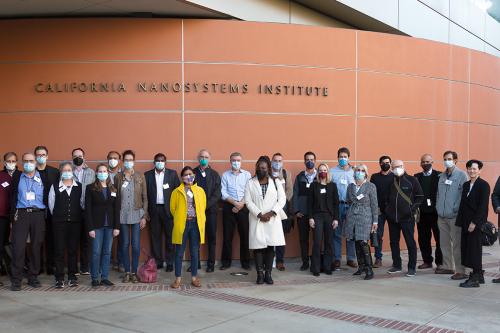
Building robust collaborations to “ATTACK” future pandemics
As COVID-19 pandemic continues, the development of antiviral drug treatments has become a critical weapon in our arsenal against the virus.
Harnessing the research and scientific brainpower needed to treat and prevent the next pandemic is the University of California – National Labs Antiviral Treatments Targeting All Coronaviruses and Key RNA viruses (ATTACK) Consortium.
The group integrates expertise and resources from six University of California (UC) campuses at Los Angeles, San Diego, Davis, Berkeley, Irvine and Riverside; two national laboratories, Lawrence Livermore and Sandia, and 13 industry partners.
“Putting such expertise under one roof will help alleviate much of the silos that have plagued previous antiviral drug development,” said Brigitte Gomperts, professor of pediatrics and pulmonary medicine, a member of the Eli and Edythe Broad Center of Regenerative Medicine and Stem Cell Research at UCLA and a center director and co-principal investigator of a recent ATTACK Consortium funding proposal to develop antiviral drugs to treat and prevent future pandemics.
“That is our ultimate, overall goal,” said Gomperts. “We want to prevent and be prepared for the next pandemic.”
When the next pandemic arrives is a matter of when, according to the researchers, not if.
UCLA virologist, Vaithilingaraja Arumugaswami, an associate professor of molecular and medical pharmacology at UCLA and member of the ATTACK Consortium executive committee, has been working on viruses and infectious diseases for years.
“We need a combination of antivirals and vaccines to kick the virus and kick the pandemic,” said Arumugaswami. “Antiviral drug development is crucial.”
“The extraordinary measures of this pandemic have created an opportunity,” said Arumugaswami. “I never thought I’d see over 50 of the world’s top researchers across a variety of disciplines coming together to attack this problem.”
Collaboration and expertise
On a recent day at the California NanoSystems Institute (CNSI) at UCLA those 50 top research minds in antiviral drug development gathered in-person and virtually to extend the robust collaboration of research, resources and support they have generated together.
David Smith, an infectious disease physician, professor of medicine at UCSD, and a viral researcher is also a center director and co-principal investigator for the group.
“I was awed by the intelligence in the room and the ability to solve these complex problems and prevent future pandemics,” said Smith. “The ATTACK Consortium is bringing ideas from the bench to the bedside through motivation, collaboration and trust. We have partners as part of the consortium who can move ideas and discoveries to the clinic through their expertise and abilities and that is enabling us to work at a quick pace.”
The ATTACK Consortium meeting has allowed new collaborations and experiments to get off the ground in the short term with a long-term eye to developing the pipeline that exists across the UC campuses and national labs.
The group has quickly developed an expertly efficient pipeline that starts with discovery and ends with highly effective direct acting antiviral therapies that have met all the needed pre-clinical testing to enter human trials.
“We have picked up the ball and we are running with it,” said Smith. “We have learned from past pandemics as far back as the HIV virus 40 years ago and those that have come since (Ebola, Zika, MERS, SARS) and we are better at predicting what viruses may present in the future and the hope of this group is to develop what treatment could be used for them.”
National laboratory, industry resources
The speed of collaboration is underscored by support from the national laboratories and industry partners. National lab partners, Lawrence Livermore National Lab and Sandia National Lab, fall under the Department of Energy’s National Nuclear Security Administration Laboratories.
The Energy Department’s 17 National Labs tackle the critical scientific challenges of our time and possess unique instruments and facilities, many of which are found nowhere else in the world. They address large-scale, complex research and development challenges with a multidisciplinary approach that places an emphasis on translating basic science to innovation.
“As a partner, the national laboratories have served as leading institutions for scientific innovation in the US for more than seventy years,” said Robert Damoiseaux, UCLA site lead and member of the executive committee of the ATTACK Consortium and professor of molecular and medical pharmacology and bioengineering.
In his role as director of the Molecular Screening Shared Resource (MSSR) at the CNSI at UCLA, Damoiseaux has worked closely with the national laboratories and industry partners on previous collaborations and knew adding their brainpower and resources to the ATTACK Consortium would extend the capabilities and strengths of the group considerably.
“The national labs have resources and interest in antiviral drug discovery that adds another dimension to what we can do,” said Damoiseaux. “And this allows us as a public entity to have a very different approach that is transparent and community focused than other groups, which can impact the public good on a wider scale.”
Felice Lightstone is the group leader of Biochemical and Biophysical Systems and Associate Program Lead for Medical Counter Measures at Lawrence Livermore National Laboratory.
“The national labs offer not only high-performance computing and BSL-3 (Biosafety level) laboratories for select agent research,” said Lightstone. “We also make technologies that can make the drug design process more efficient and more effective.”
The national labs also bridge academia and industry, having a long process of collaboration with nonprofits and government entities.
“This is cutting edge research,” said Lightstone. “With this group we can fully integrate the drug development process. For example, while we are designing drugs for efficacy, we should also be developing in parallel safety profiles for the drug. If we are looking at efficacy and safety at the same time, then we can simultaneously shorten the drug development timeline.”
Research already underway
For the ATTACK Consortium, that cutting edge research is already underway.
“We took a divide and conquer approach, and everyone chipped in their strengths and capabilities to ‘ATTACK’ this global health problem, hence the name of the consortium,” said Damoiseaux.
For now, the five highly integrated research projects and four scientific cores are working to achieve the Consortium’s goals. The research projects include:
- Artificial Intelligence (AI) and Machine Learning (ML) Drug Discovery
- Novel Ultra High Throughput Drug Screening
- Drug Optimization for IND enabling studies
- Viral RNA Targets
- Viral Protease Targets
Adam Zemla, a researcher at Lawrence Livermore and Adam Godzik, professor of biomedical sciences at UC Riverside, are just two researchers collaborating on ATTACK research projects, analyzing the Omicron variant for the possible consequential mutations.
“With each outbreak there is so much unknown about what may happen next, and how a virus can evolve. A better understanding of the complexity of the problem is needed to help achieve our goals and have an effective and rapid response,” said Zemla. “We are moving forward toward the Consortium’s goals by bringing in experts in these fields to advance our solutions and responses now and make us better prepared for the next pandemic.”
A promise for the future
It remains to be seen what will be achieved by the ATTACK Consortium group, yet as Damoiseaux says by sheer size and motivation the odds are in their favor as evidenced by the seventeen peer-reviewed publications from the ATTACK Consortium members just within the last two months.
“We are a conglomerate and one of the biggest academic groups to tackle this problem and go after these types of solutions,” said Damoiseaux. “It is necessary to do this work to discover treatments and drugs to treat and prevent future pandemics and protect the health of our global population. If we do this, then we will be ready.”
Indeed, the ATTACK Consortium was able to work very quickly to find new potential therapeutic strategies for the Omicron variant. Team members recently finished the characterization of therapeutic nanobodies (a form of antibodies) that have activity against Omicron, as well as the previous Delta variant of SARS-CoV-2. Researchers also found an RNA inhibitor that targets Omicron. Both strategies could be foundational for new broadly acting SARS-CoV-2 therapeutics.
About the University of California – National Lab The UC-NL Antiviral Treatments Targeting All Coronaviruses and Key RNA viruses (ATTACK) Consortium
The ATTACK Consortium comprises world class academic researchers who have joined together to develop a comprehensive and sustainable solution for the rapid and rigorous discovery and development of antiviral drugs with the goal to help solve the current COVID-19 crisis and prevent the next pandemic.
The ATTACK Consortium integrates expertise and resources from six University of California (UC) campuses at Los Angeles, San Diego, Davis, Berkeley, Irvine, and Riverside; two national laboratories, Lawrence Livermore and Sandia, and 13 industry partners.
Organized into five key integrated research project areas and four scientific cores, the consortium provides a rigorous pipeline for antiviral drug discovery, identification of specific viral targets and drug optimization with initial work on coronaviruses, enterovirus D68, dengue virus and Nipah virus. The ATTACK Consortium is further enhanced by collaborations with industry partners and other laboratories with BSL-4 capabilities and select agent testing capabilities.

